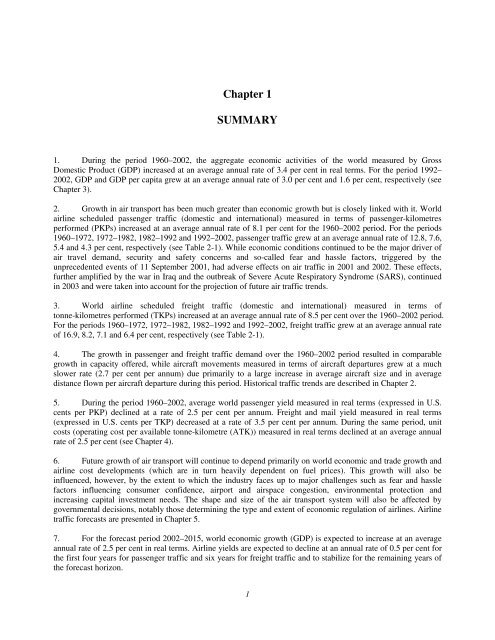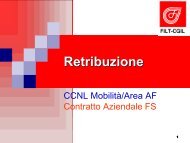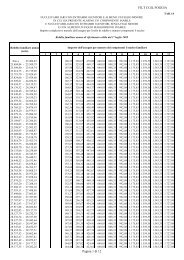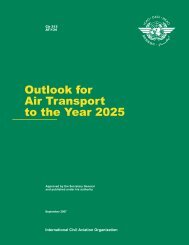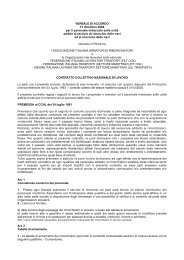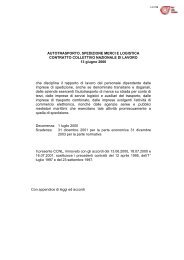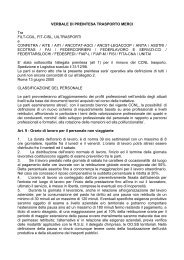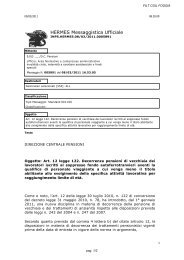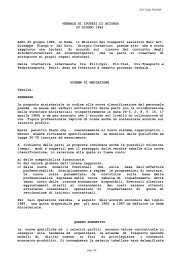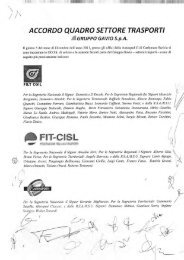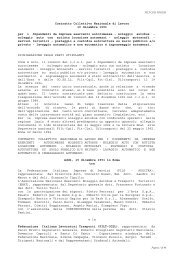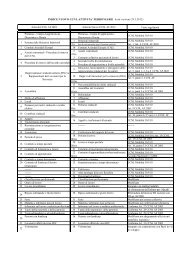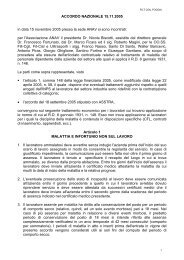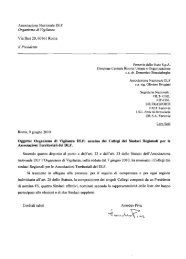Outlook for Air Transport to the Year 2015 - FILT CGIL Foggia
Outlook for Air Transport to the Year 2015 - FILT CGIL Foggia
Outlook for Air Transport to the Year 2015 - FILT CGIL Foggia
Create successful ePaper yourself
Turn your PDF publications into a flip-book with our unique Google optimized e-Paper software.
Chapter 1SUMMARY1. During <strong>the</strong> period 1960–2002, <strong>the</strong> aggregate economic activities of <strong>the</strong> world measured by GrossDomestic Product (GDP) increased at an average annual rate of 3.4 per cent in real terms. For <strong>the</strong> period 1992–2002, GDP and GDP per capita grew at an average annual rate of 3.0 per cent and 1.6 per cent, respectively (seeChapter 3).2. Growth in air transport has been much greater than economic growth but is closely linked with it. Worldairline scheduled passenger traffic (domestic and international) measured in terms of passenger-kilometresper<strong>for</strong>med (PKPs) increased at an average annual rate of 8.1 per cent <strong>for</strong> <strong>the</strong> 1960–2002 period. For <strong>the</strong> periods1960–1972, 1972–1982, 1982–1992 and 1992–2002, passenger traffic grew at an average annual rate of 12.8, 7.6,5.4 and 4.3 per cent, respectively (see Table 2-1). While economic conditions continued <strong>to</strong> be <strong>the</strong> major driver ofair travel demand, security and safety concerns and so-called fear and hassle fac<strong>to</strong>rs, triggered by <strong>the</strong>unprecedented events of 11 September 2001, had adverse effects on air traffic in 2001 and 2002. These effects,fur<strong>the</strong>r amplified by <strong>the</strong> war in Iraq and <strong>the</strong> outbreak of Severe Acute Respira<strong>to</strong>ry Syndrome (SARS), continuedin 2003 and were taken in<strong>to</strong> account <strong>for</strong> <strong>the</strong> projection of future air traffic trends.3. World airline scheduled freight traffic (domestic and international) measured in terms of<strong>to</strong>nne-kilometres per<strong>for</strong>med (TKPs) increased at an average annual rate of 8.5 per cent over <strong>the</strong> 1960–2002 period.For <strong>the</strong> periods 1960–1972, 1972–1982, 1982–1992 and 1992–2002, freight traffic grew at an average annual rateof 16.9, 8.2, 7.1 and 6.4 per cent, respectively (see Table 2-1).4. The growth in passenger and freight traffic demand over <strong>the</strong> 1960–2002 period resulted in comparablegrowth in capacity offered, while aircraft movements measured in terms of aircraft departures grew at a muchslower rate (2.7 per cent per annum) due primarily <strong>to</strong> a large increase in average aircraft size and in averagedistance flown per aircraft departure during this period. His<strong>to</strong>rical traffic trends are described in Chapter 2.5. During <strong>the</strong> period 1960–2002, average world passenger yield measured in real terms (expressed in U.S.cents per PKP) declined at a rate of 2.5 per cent per annum. Freight and mail yield measured in real terms(expressed in U.S. cents per TKP) decreased at a rate of 3.5 per cent per annum. During <strong>the</strong> same period, unitcosts (operating cost per available <strong>to</strong>nne-kilometre (ATK)) measured in real terms declined at an average annualrate of 2.5 per cent (see Chapter 4).6. Future growth of air transport will continue <strong>to</strong> depend primarily on world economic and trade growth andairline cost developments (which are in turn heavily dependent on fuel prices). This growth will also beinfluenced, however, by <strong>the</strong> extent <strong>to</strong> which <strong>the</strong> industry faces up <strong>to</strong> major challenges such as fear and hasslefac<strong>to</strong>rs influencing consumer confidence, airport and airspace congestion, environmental protection andincreasing capital investment needs. The shape and size of <strong>the</strong> air transport system will also be affected bygovernmental decisions, notably those determining <strong>the</strong> type and extent of economic regulation of airlines. <strong>Air</strong>linetraffic <strong>for</strong>ecasts are presented in Chapter 5.7. For <strong>the</strong> <strong>for</strong>ecast period 2002–<strong>2015</strong>, world economic growth (GDP) is expected <strong>to</strong> increase at an averageannual rate of 2.5 per cent in real terms. <strong>Air</strong>line yields are expected <strong>to</strong> decline at an annual rate of 0.5 per cent <strong>for</strong><strong>the</strong> first four years <strong>for</strong> passenger traffic and six years <strong>for</strong> freight traffic and <strong>to</strong> stabilize <strong>for</strong> <strong>the</strong> remaining years of<strong>the</strong> <strong>for</strong>ecast horizon.1


